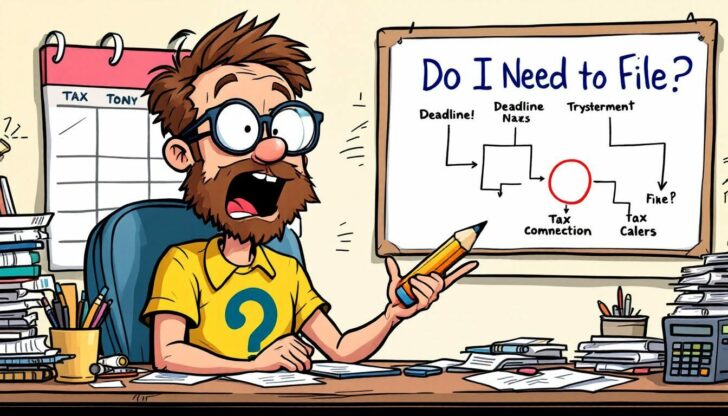Filing your taxes can seem overwhelming, but it doesn’t have to be. This guide on how to file your federal income tax return simplifies the process by breaking it down into clear, manageable steps. You’ll learn how to determine your filing status, gather necessary documents, and choose the best filing method. Let’s get started and take the stress out of tax season.
Table of Contents
Key Takeaways
Determine your filing status to maximize deductions and credits based on your personal circumstances.
Gather and organize all necessary tax documents in advance to ensure accurate filing and avoid last-minute stress.
Choose a suitable filing method, whether electronic, paper, or professional assistance, to streamline the process and reduce potential errors.
Determine Your Filing Status

Determining your filing status is a critical first step in filing your federal tax return. This choice affects your standard deduction and eligibility for various credits and deductions.
There are five recognized filing statuses:
Single
Married filing jointly
Married filing separately
Head of household
Qualifying surviving spouse
If you are unmarried or legally separated on the last day of the tax year, you would typically file as ‘Single’. Couples who are married might choose to file jointly, which means combining their incomes and deductions on a single tax return. This status often offers the most significant tax benefits, including a higher standard deduction of $27,700 for 2023. Alternatively, some married couples may opt to file separately to limit their tax liability to their income alone.
The ‘Head of Household’ status is available to unmarried individuals who maintain a home for a qualifying person, such as a child, for most of the year. For those who have lost a spouse, the ‘Qualifying Surviving Spouse’ status allows the use of joint return tax rates for two years following the spouse’s death.
Choose the filing status that minimizes your tax liability by carefully considering your marital status and household contributions.
Gather Your Tax Documents

Gather all your tax documents ahead of filing to ensure your tax return is accurate and complete. By January or February, expect to receive income documents like W-2s from employers and 1099s for freelance or independent contractor work. These forms provide the necessary information to report your earnings accurately. Gathering these documents is crucial to accurately calculate your expected refund.
You’ll also need records of any expenses that qualify for deductions. This includes documents related to mortgage interest, charitable donations, and healthcare expenses. Keeping these documents organized will help you claim all the deductions and credits you are entitled to, potentially reducing your tax liability.
Organizing your tax documents not only ensures accuracy but also makes the filing process smoother. When everything is organized and easily accessible, you can focus on completing your tax return without the last-minute scramble to find missing information. This organization can also be helpful if you ever need to reference these documents in the future.
Calculate Your Income
Accurate calculation of your total income is essential for filing your tax return. Your total income includes various sources such as employment income, rental property income, and income from investments. For instance, if you have rental properties, you must report all rental income, including advance rent and any payments received for canceling a lease.
To document your income, you will typically receive forms such as Form W-2 from employers, Form 1099-NEC for freelance work, and Forms 1099-DIV and 1099-INT for dividends and interest income. Listing all these incomes on your tax return ensures you meet your obligations and avoid penalties.
Understand Deductions and Credits
Deductions and credits are powerful tools that can significantly reduce your tax liability. Deductions lower your taxable income, which in turn reduces the amount of tax you owe. For example, if you have student loans, you can deduct the interest paid on those loans from your taxable income. Similarly, if you own rental properties, you can deduct necessary expenses like mortgage interest and repairs.
Tax credits, on the other hand, directly reduce the amount of tax you owe, and some are even refundable. The Child Tax Credit (CTC) is a common example, providing financial relief to parents with qualifying children. The Earned Income Tax Credit (EITC) is another credit available to low-to-moderate-income workers, potentially resulting in a significant refund.
Given the complexity of navigating deductions and credits, consulting a tax professional can be beneficial. They can help identify opportunities to minimize your tax liability that you might overlook. Filing status also plays a role in determining eligibility for certain deductions and credits, making it crucial to choose the correct status.
Understanding Your Tax Return
Understanding your tax return is crucial to ensure you’re taking advantage of all the credits and deductions you’re eligible for. A tax return is a form that you submit to the government to report your income, expenses, and other relevant financial information. It’s used to calculate the amount of taxes you owe or the amount of your refund.
When reviewing your tax return, make sure to check for accuracy and completeness. Verify that all your income, including wages, salaries, tips, and unemployment income, is reported correctly. Also, ensure that you’ve claimed all the deductions and credits you’re eligible for, such as the Earned Income Tax Credit (EITC) and the Child Tax Credit (CTC).
If you’re using a tax preparer, make sure to review your return carefully before signing it. Ask questions if you’re unsure about anything, and ensure that you understand the tax preparation fee and any other charges.
Choose a Filing Method

The right filing method can streamline your process and help you avoid pitfalls. There are three primary methods: electronic filing, paper forms, and hiring a tax professional. Each method has its advantages and considerations.
E-filing, or electronic filing, is the fastest and most convenient method, often resulting in quicker refunds.
Paper forms are a traditional method, involving mailing your completed tax documents to the IRS.
Hiring a tax preparer can provide peace of mind, especially for those with complex tax situations.
Electronic Filing
E-filing offers numerous benefits, making it a popular choice for many taxpayers. It provides a guided, step-by-step process that simplifies tax filing. One of the most significant advantages is the faster processing time, with refunds often issued within 2 to 3 weeks.
Another benefit of filing electronically is the convenience of direct deposit for refunds, which is safer and quicker than waiting for a mailed check. If you meet certain eligibility criteria, you can even file your return for free online through IRS Direct File.
Paper Forms
Filing with paper forms is a more traditional method that some people prefer. This process involves filling out your tax documents by hand and mailing them to the IRS.
While this method can be more time-consuming and typically results in slower refunds, it is still a valid option for those who prefer not to file electronically or hire a professional.
Hiring a Tax Professional
For individuals with complicated tax situations, such as business owners or those with multiple income sources, hiring a tax professional can be particularly beneficial. Tax professionals guarantee 100% accuracy on your tax returns, significantly reducing the risk of errors.
While there is a cost associated with hiring a professional, the peace of mind and potential tax savings can be worth the investment. They can also provide valuable advice on tax planning and ensure that you take advantage of all available deductions and credits. Tax professionals can also assist with understanding and applying for financial products like a refund advance loan.
File Your Return
After gathering your documents, calculating your income, and choosing a filing method, you are ready to file your return. Some tax preparers offer refund advance loans, which allow you to access a portion of your anticipated refund early. Ensure that you check for any recent tax law changes that might affect your return. Whether you file electronically or by paper, make sure all information is accurate and complete to avoid delays.
Filing electronically is straightforward, allowing you to sign your return digitally. For those using paper forms, remember that the processing time is longer, and you should allow extra time for your return to be received and processed.
Always verify your bank account details if you opt for direct deposit to receive your refund efficiently.
After Filing Your Tax Return
After filing your tax return, you can expect to receive your refund or pay any taxes owed. If you’re due a refund, you can choose to have it direct deposited into your bank account or receive a paper check. If you owe taxes, you can pay online, by phone, or by mail.
It’s essential to keep a copy of your tax return and supporting documents for at least three years in case of an audit or if you need to refer to them in the future.
Track Your Refund
After filing, track the status of your refund using the IRS’s ‘Where’s My Refund’ tool on IRS.gov. To use this tool, you will need your Social Security number, filing status, and the exact refund amount.
The tool updates the status of your refund in three stages: ‘Return received,’ ‘Refund approved,’ and ‘Refund sent’. Most refunds are issued within 21 days of e-filing, though some returns may take longer if they require additional review.
This tracking feature helps you stay informed about when to expect your refund.
Avoid Common Mistakes
Avoiding common mistakes helps prevent unnecessary delays and penalties. One prevalent error is filing before receiving all necessary documents, which can lead to inaccuracies. Ensure that all Social Security numbers on your return match those on your Social Security cards to avoid submission issues.
Double-check all entered information, including income, deductions, and credits, to prevent errors. Math errors are also common, so reviewing your calculations can help ensure correct submissions. If you feel uncertain, consider hiring a professional to assist you with the filing process.
What to Do If You Owe Taxes
If you owe taxes, don’t panic. The IRS offers payment plans to help manage your obligations. Individuals can qualify for a short-term payment plan if they owe less than $100,000 in total tax obligations. These plans allow you to pay your taxes over time, making it more manageable.
Filing for an extension does not extend the time to pay any taxes owed. To avoid penalties, ensure that your payments are made by the original filing deadline. If you’re unsure about the best approach, consulting a tax professional can provide guidance and help you set up a payment plan that works for you.
Learn more, 5 Things You Shouldn’t Do If You Owe the IRS at Tax Time.
Protect Yourself from Scams
Tax season is a prime time for scams, so stay vigilant. Be wary of tax scams that promise unusually high tax refund amounts or demand immediate payment with threats of arrest or deportation. These tactics are often used by scammers to exploit unsuspecting taxpayers.
The IRS does not initiate contact through social media or ask for payment via prepaid cards or advance loans. Always verify the legitimacy of any communication claiming to be from the IRS. Staying informed about common tax scams can help you protect yourself effectively.
Getting Help with Tax Filing
If you need help with tax filing, there are several resources available. You can contact the IRS directly or visit their website for information on tax credits, deductions, and filing requirements. You can also seek the help of a tax preparer or use tax preparation software.
Summary
Filing your taxes doesn’t have to be a daunting task. By following the steps outlined in this guide, you can navigate the tax filing process with confidence. Start by determining your filing status, gathering all necessary documents, and calculating your income accurately. Understand the deductions and credits available to you, and choose the filing method that best suits your needs.
Remember to file your return on time, track your refund, and avoid common mistakes. If you owe taxes, explore payment plans to manage your obligations. Stay vigilant against scams to protect your personal information. With these tips, you’ll be well-equipped to handle tax season smoothly and efficiently.
Frequently Asked Questions
What should I do if I haven’t received all my tax documents by the time I’m ready to file?
If you haven’t received all your tax documents, such as your W-2 or 1099 forms, by the time you’re ready to file, you can contact your employer or the issuer of the document to request a copy. You can also contact the IRS for assistance.
Can I still file my tax return if I missed the filing deadline?
If you missed the filing deadline, you can still file your tax return, but you may be subject to penalties and interest on any taxes owed. You can file for an extension, which will give you an additional six months to file your return. However, you’ll still need to pay any taxes owed by the original deadline to avoid penalties and interest.
It’s essential to note that if you’re due a refund, you can still file your return and receive your refund, even if you missed the deadline. However, if you owe taxes, it’s crucial to file as soon as possible to minimize penalties and interest.
What should I do if I haven’t received all my tax documents by the time I’m ready to file?** **?
It’s important to ensure you have all necessary tax documents before filing to prevent errors. If key documents like your W-2 or 1099s are missing by mid-February, reach out to the issuer for a copy.
Can I still file my tax return if I missed the filing deadline?** **?
You can still file your tax return after the deadline, but be aware that penalties and interest may apply on any taxes owed. It’s advisable to file promptly to reduce these potential costs.
How can I track the status of my tax refund?** **?
You can easily track your tax refund using the IRS’s ‘Where’s My Refund’ tool on IRS.gov. Just provide your Social Security number, filing status, and the exact refund amount to get the status.
What should I do if I can’t pay the full amount of taxes I owe?** **?
If you can’t pay your full tax amount, consider applying for an IRS payment plan, especially if your owed amount is under $100,000. Setting up a plan is crucial to mitigate penalties and interest.
How can I avoid tax scams?** **?
To avoid tax scams, be wary of unsolicited offers of high refunds or threats of payment, as the IRS does not conduct business via social media or request payments through prepaid cards. Always verify the authenticity of any correspondence you receive from the IRS.








